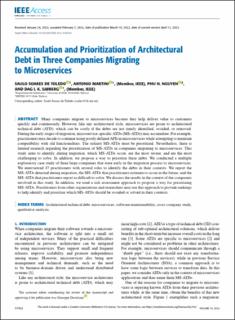| dc.contributor.author | Soares de Toledo, Saulo | |
| dc.contributor.author | Martini, Antonio | |
| dc.contributor.author | Nguyen, Phu Hong | |
| dc.contributor.author | Sjøberg, Dag | |
| dc.date.accessioned | 2022-08-26T08:20:46Z | |
| dc.date.available | 2022-08-26T08:20:46Z | |
| dc.date.created | 2022-04-04T22:09:05Z | |
| dc.date.issued | 2022 | |
| dc.identifier.citation | IEEE Access. 2022, 10, 37422-37445. | en_US |
| dc.identifier.issn | 2169-3536 | |
| dc.identifier.uri | https://hdl.handle.net/11250/3013711 | |
| dc.description.abstract | Many companies migrate to microservices because they help deliver value to customers quickly and continuously. However, like any architectural style, microservices are prone to architectural technical debt (ATD), which can be costly if the debts are not timely identified, avoided, or removed. During the early stages of migration, microservice-specific ATDs (MS-ATDs) may accumulate. For example, practitioners may decide to continue using poorly defined APIs in microservices while attempting to maintain compatibility with old functionalities. The riskiest MS-ATDs must be prioritized. Nevertheless, there is limited research regarding the prioritization of MS-ATDs in companies migrating to microservices. This study aims to identify, during migration, which MS-ATDs occur, are the most severe, and are the most challenging to solve. In addition, we propose a way to prioritize these debts. We conducted a multiple exploratory case study of three large companies that were early in the migration process to microservices. We interviewed 47 practitioners with several roles to identify the debts in their contexts. We report the MS-ATDs detected during migration, the MS-ATDs that practitioners estimate to occur in the future, and the MS-ATDs that practitioners report as difficult to solve. We discuss the results in the context of the companies involved in this study. In addition, we used a risk assessment approach to propose a way for prioritizing MS-ATDs. Practitioners from other organizations and researchers may use this approach to provide rankings to help identify and prioritize which MS-ATDs should be avoided or solved in their contexts. | en_US |
| dc.language.iso | eng | en_US |
| dc.publisher | Institute of Electrical and Electronics Engineers (IEEE) | en_US |
| dc.rights | Navngivelse 4.0 Internasjonal | * |
| dc.rights.uri | http://creativecommons.org/licenses/by/4.0/deed.no | * |
| dc.subject | Architectural technical debt | en_US |
| dc.subject | Microservices | en_US |
| dc.subject | Software maintainability | en_US |
| dc.subject | Cross-company study | en_US |
| dc.subject | Qualitative analysis | en_US |
| dc.title | Accumulation and Prioritization of Architectural Debt in Three Companies Migrating to Microservices | en_US |
| dc.title.alternative | Accumulation and Prioritization of Architectural Debt in Three Companies Migrating to Microservices | en_US |
| dc.type | Peer reviewed | en_US |
| dc.type | Journal article | en_US |
| dc.description.version | publishedVersion | en_US |
| dc.source.pagenumber | 37422-37445 | en_US |
| dc.source.volume | 10 | en_US |
| dc.source.journal | IEEE Access | en_US |
| dc.identifier.doi | 10.1109/ACCESS.2022.3158648 | |
| dc.identifier.cristin | 2015261 | |
| cristin.ispublished | true | |
| cristin.fulltext | original | |
| cristin.qualitycode | 1 | |

